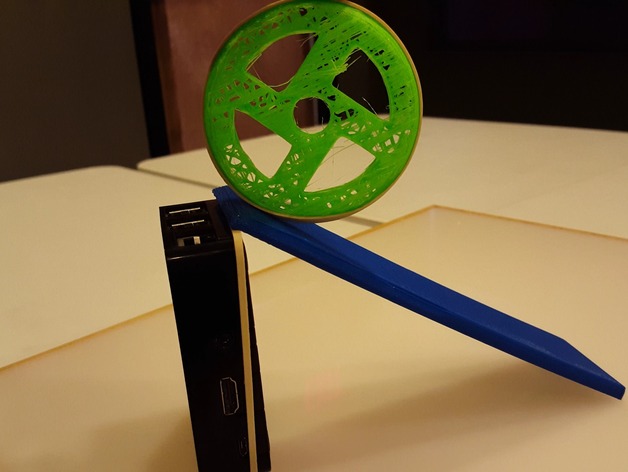

Physics Demo - Analyzing Angular Inertia of Wheels of Differing Thicknesses
thingiverse
Physics Demo - Exploring Rotational Speed of Wheels with Varied Masses In this project, students will investigate how differences in rotational speed affect wheels of various densities (infill percentages) printed using 3D technology. By testing three distinct wheels, students can develop a deeper understanding of how mass influences the speed at which objects rotate down a ramp. This demonstration is ideal for introducing new concepts related to circular motion, angular momentum, and potential energy. The project's sample 3D STL file, borrowed from user timelapse21, is available on Thingiverse (https://www.thingiverse.com/thing:1378432). Print Settings: Printer: Flashforge 3D Creator Pro Rafts: Not Required Supports: Not Required Resolution: .27 mm Infill: 5%, 25%, 50% Notes: Rafting and supports are not necessary for this print. The primary focus is on printing three wheels with varying infill percentages (5%, 25%, 50%). Post-Printing: *Not the highest quality print, but an idea of what the shape looks like when complete* This wheel also features a rubber band to enhance grip on the ramp. Designing This Project: For this demonstration, students only need the printed wheel, a rubber band, a small ramp (e.g., a ruler), and something to support the ramp. A stopwatch or recording device is helpful for measuring time and observing the effects of mass on rotational speed. Standards: NGSS HS-PS2-6: Communicate scientific and technical information about why obtaining, evaluating, and communicating information are essential in all aspects of life, including science. Overview and Background: Given the ease of adjusting 3D print densities, instructors can introduce new physics concepts, such as angular momentum, using this project. By printing three wheels with different infill percentages, instructors can work with students to explore physical concepts related to circular motion, angular momentum, and potential energy. Objectives: Students will evaluate and discuss the differences in rotational speed of 3D printed wheels with varying densities. Audiences: Grades (7-12) Ages (12-18) Skills Required: *Physics knowledge: kinematics, dynamics, circular motion Subjects: Science Physics Skills Learned (Standards): HS-PS2-6: Communicate scientific and technical information about why obtaining, evaluating, and communicating information are essential in all aspects of life, including science. Lesson Plan and Activity: Step 1: Set up the ramp and three different wheels with rubber bands wrapped around them. Step 2: Explain what is occurring in the demonstration and set up recording devices. Step 3: Roll down each wheel and record it as it rolls down and off the ramp. Step 4: Reexamine the video recording at different speeds (normal, slow, slowest) to observe the differences in rotational speed of each wheel. Step 5: Have students determine which wheel has the highest density, medium, lowest. Step 6: Discuss why mass might affect the rotational speed of the wheel. Step 7: Tie into other learning objectives of the day. Materials Needed: *Demonstration space *3D printer to make wheels (3) *Rubber bands (3) to wrap around the circumference of the wheel *Ramp (could use a book, ruler, etc.) *Camera (smartphone camera can work) *Timer (if needed) *Ruler (if necessary) Duration of Lesson: This project will only require about 15 minutes to 30 minutes to conduct. References: http://www.nextgenscience.org/dci-arrangement/hs-ps2-motion-and-stability-forces-and-interactions Handouts & Assets: None needed. This demonstration is intended to be presented and discussed. Demonstration Example: Example video of how the demonstration can be conducted. Taking video of each roll down the ramp can be useful in addition to applying different changes in video speeds to better visualize the effect of increased mass on rotational speed.

With this file you will be able to print Physics Demo - Analyzing Angular Inertia of Wheels of Differing Thicknesses with your 3D printer. Click on the button and save the file on your computer to work, edit or customize your design. You can also find more 3D designs for printers on Physics Demo - Analyzing Angular Inertia of Wheels of Differing Thicknesses.
